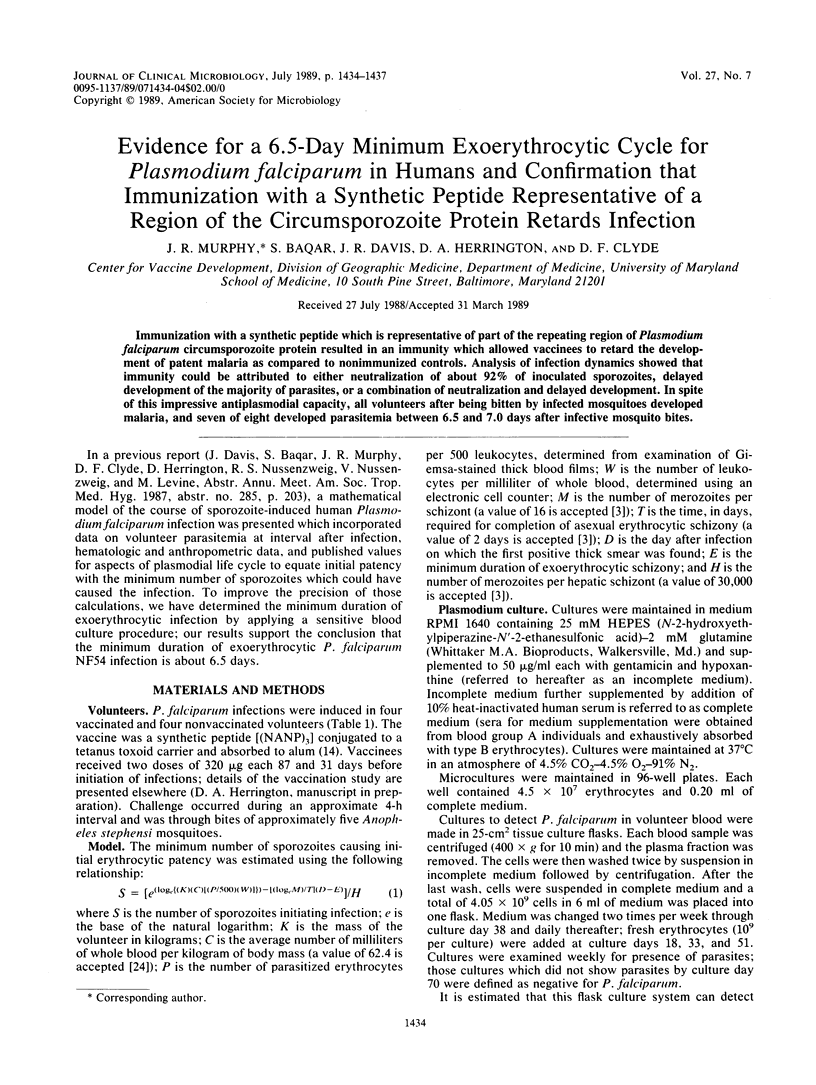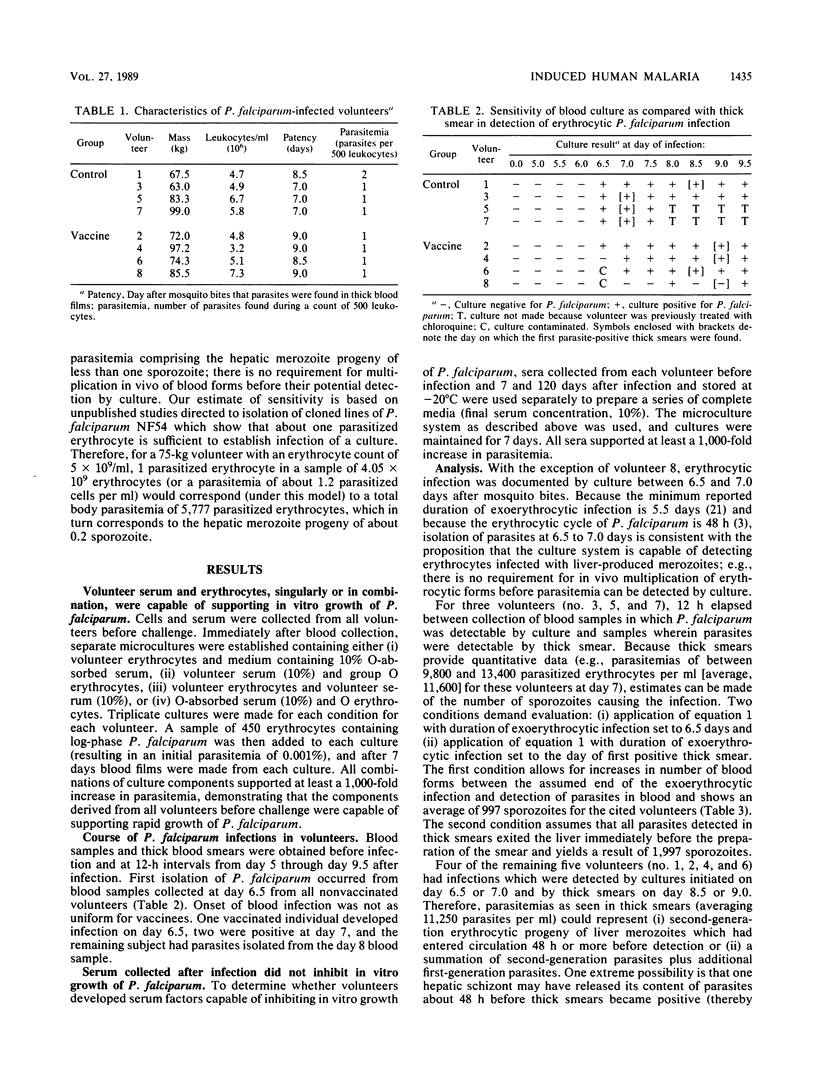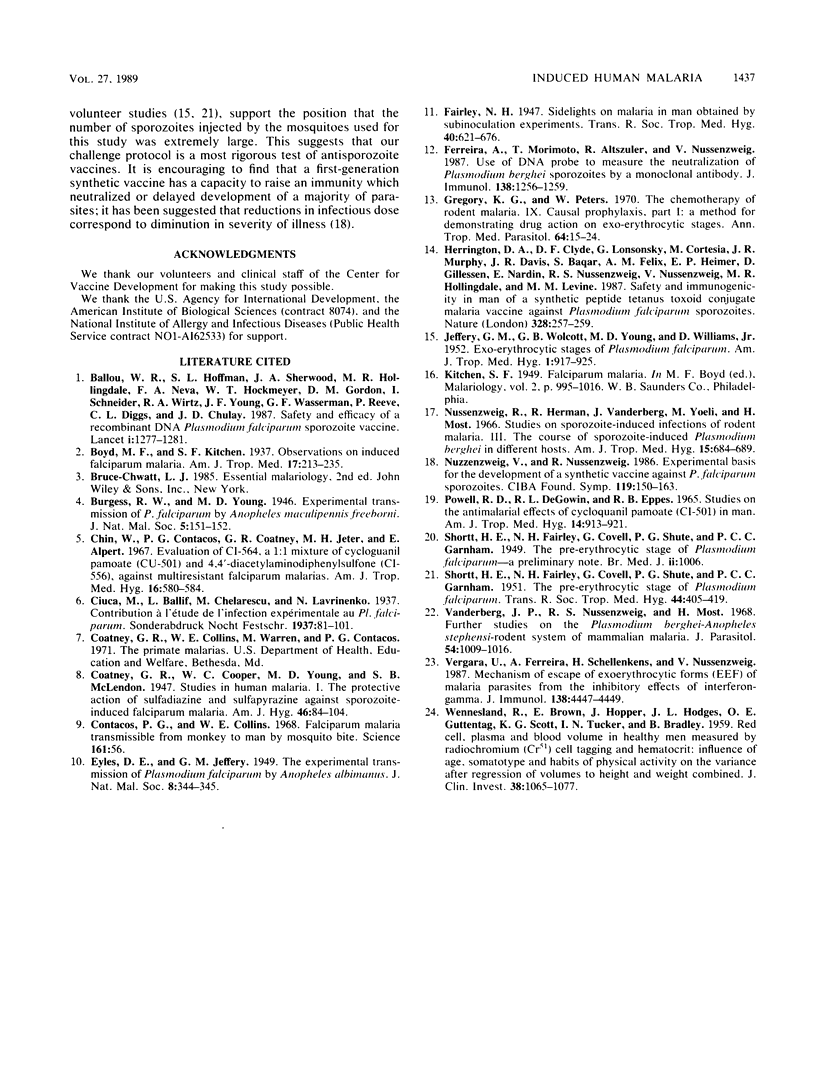Abstract
Immunization with a synthetic peptide which is representative of part of the repeating region of Plasmodium falciparum circumsporozoite protein resulted in an immunity which allowed vaccinees to retard the development of patent malaria as compared to nonimmunized controls. Analysis of infection dynamics showed that immunity could be attributed to either neutralization of about 92% of inoculated sporozoites, delayed development of the majority of parasites, or a combination of neutralization and delayed development. In spite of this impressive antiplasmodial capacity, all volunteers after being bitten by infected mosquitoes developed malaria, and seven of eight developed parasitemia between 6.5 and 7.0 days after infective mosquito bites.
Full text
PDF



Selected References
These references are in PubMed. This may not be the complete list of references from this article.
- Ballou W. R., Hoffman S. L., Sherwood J. A., Hollingdale M. R., Neva F. A., Hockmeyer W. T., Gordon D. M., Schneider I., Wirtz R. A., Young J. F. Safety and efficacy of a recombinant DNA Plasmodium falciparum sporozoite vaccine. Lancet. 1987 Jun 6;1(8545):1277–1281. doi: 10.1016/s0140-6736(87)90540-x. [DOI] [PubMed] [Google Scholar]
- Chin W., Contacos P. G., Coatney G. R., Jeter M. H., Alpert E. Evaluation of CI-564, A 1:1 mixture of cycloguanil pamoate (CI-501) and 4,4'-diacetylaminodiphenylsulfone (CI-556), against multiresistant falciparum malarias. Am J Trop Med Hyg. 1967 Sep;16(5):580–584. doi: 10.4269/ajtmh.1967.16.580. [DOI] [PubMed] [Google Scholar]
- Contacos P. G., Collins W. E. Falciparum malaria transmissible from monkey to man by mosquito bite. Science. 1968 Jul 5;161(3836):56–56. doi: 10.1126/science.161.3836.56. [DOI] [PubMed] [Google Scholar]
- EYLES D. E., JEFFERY G. M. The experimental transmission of Plasmodium falciparum by Anopheles albimanus. J Natl Malar Soc. 1949 Dec;8(4):344–344. [PubMed] [Google Scholar]
- Ferreira A., Morimoto T., Altszuler R., Nussenzweig V. Use of a DNA probe to measure the neutralization of Plasmodium berghei sporozoites by a monoclonal antibody. J Immunol. 1987 Feb 15;138(4):1256–1259. [PubMed] [Google Scholar]
- Gregory K. G., Peters W. The chemotherapy of rodent malaria. IX. Causal prophylaxis. I. A method for demonstrating drug action on exo-erythrocytic stages. Ann Trop Med Parasitol. 1970 Mar;64(1):15–24. [PubMed] [Google Scholar]
- Herrington D. A., Clyde D. F., Losonsky G., Cortesia M., Murphy J. R., Davis J., Baqar S., Felix A. M., Heimer E. P., Gillessen D. Safety and immunogenicity in man of a synthetic peptide malaria vaccine against Plasmodium falciparum sporozoites. Nature. 1987 Jul 16;328(6127):257–259. doi: 10.1038/328257a0. [DOI] [PubMed] [Google Scholar]
- JEFFERY G. M., WOLCOTT G. B., YOUNG M. D., WILLIAMS D., Jr Exo-erythrocytic stages of Plasmodium falciparum. Am J Trop Med Hyg. 1952 Nov;1(6):917–925. doi: 10.4269/ajtmh.1952.1.917. [DOI] [PubMed] [Google Scholar]
- Nussenzweig R., Herman R., Vanderberg J., Yoeli M., Most H. Studies on sporozoite-induced infections of rodent malaria. 3. The course of sporozoite-induced Plasmodium berghei in different hosts. Am J Trop Med Hyg. 1966 Sep;15(5):684–689. doi: 10.4269/ajtmh.1966.15.684. [DOI] [PubMed] [Google Scholar]
- Nussenzweig V., Nussenzweig R. Experimental basis for the development of a synthetic vaccine against Plasmodium falciparum malaria sporozoites. Ciba Found Symp. 1986;119:150–163. doi: 10.1002/9780470513286.ch9. [DOI] [PubMed] [Google Scholar]
- Powell R. D., DeGowin R. L., Eppes R. B. Studies on the antimalarial effects of cycloguanil pamoate (CI-501) in man. Am J Trop Med Hyg. 1965 Nov;14(6):913–921. doi: 10.4269/ajtmh.1965.14.913. [DOI] [PubMed] [Google Scholar]
- SHORTT H. E., FAIRLEY N. H., COVELL G., SHUTE P. G., GARNHAM P. C. C. The pre-erythrocytic stage of Plasmodium falciparum. Trans R Soc Trop Med Hyg. 1951 Feb;44(4):405–419. doi: 10.1016/s0035-9203(51)80019-1. [DOI] [PubMed] [Google Scholar]
- SHORTT H. E., FAIRLEY N. H. The pre-erythrocytic stage of Plasmodium falciparum; a preliminary note. Br Med J. 1949 Nov 5;2(4635):1006-8, illust. doi: 10.1136/bmj.2.4635.1006. [DOI] [PMC free article] [PubMed] [Google Scholar]
- Vanderberg J. P., Nussenzweig R. S., Most H. Further studies on the Plasmodium berghei-Anopheles stephensi--rodent system of mammalian malaria. J Parasitol. 1968 Oct;54(5):1009–1016. [PubMed] [Google Scholar]
- Vergara U., Ferreira A., Schellekens H., Nussenzweig V. Mechanism of escape of exoerythrocytic forms (EEF) of malaria parasites from the inhibitory effects of interferon-gamma. J Immunol. 1987 Jun 15;138(12):4447–4449. [PubMed] [Google Scholar]
- WENNESLAND R., BROWN E., HOPPER J., Jr, HODGES J. L., Jr, GUTTENTAG O. E., SCOTT K. G., TUCKER I. N., BRADLEY B. Red cell, plasma and blood volume in healthy men measured by radiochromium (Cr51) cell tagging and hematocrit: influence of age, somatotype and habits of physical activity on the variance after regression of volumes to height and weight combined. J Clin Invest. 1959 Jul;38(7):1065–1077. doi: 10.1172/JCI103883. [DOI] [PMC free article] [PubMed] [Google Scholar]


